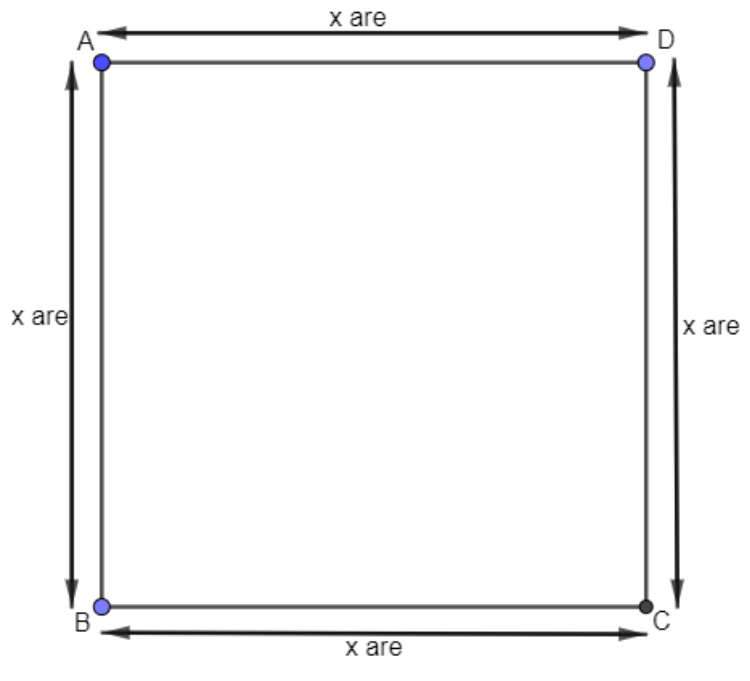
Find the sides of the square whose area is
Answer
409.8k+ views
Hint: Consider a variable (say x cm) for the length of the side of the square. Area of Square is
Complete step-by-step solution:
According to the question, the area of the square is

According to the given figure, consider the ABCD is a square whose sides are considered to be x are
That means
We know that area of square
So, the area of the square length of whose sides are ‘x’ are will be
But according to the question, the area of the square will be
So,
Taking positive square root of both sides of the equation, we will get
Hence the required side of the given square is 1 are
Now, we have to solve the first part, that is, we have to find the area in which the sides of the square are doubled.
So, new side length of the square is 2x that means
Here, as we know that value of x is 1 are that is
By simplifying this we get the value of side length of square
Now, by applying the formula, area of square
By substituting the value of new side length of square on above formula we get:
By simplifying this we get the value of area that is
Now, we have to solve the second part, that is, we have to find the area in which the sides of the square are halved.
So, new side length of the square is
Here, as we know that value of x is 1 are that is
By simplifying this we get the value of side length of square
Now, by applying the formula, area of square
By substituting the value of new side length of square on above formula we get:
By simplifying this we get the value of area that is
Hence, required area is
Note: While solving the equation
Complete step-by-step solution:
According to the question, the area of the square is

According to the given figure, consider the ABCD is a square whose sides are considered to be x are
That means
We know that area of square
So, the area of the square length of whose sides are ‘x’ are will be
But according to the question, the area of the square will be
So,
Taking positive square root of both sides of the equation, we will get
Hence the required side of the given square is 1 are
Now, we have to solve the first part, that is, we have to find the area in which the sides of the square are doubled.
So, new side length of the square is 2x that means
Here, as we know that value of x is 1 are that is
By simplifying this we get the value of side length of square
Now, by applying the formula, area of square
By substituting the value of new side length of square on above formula we get:
By simplifying this we get the value of area that is
Now, we have to solve the second part, that is, we have to find the area in which the sides of the square are halved.
So, new side length of the square is
Here, as we know that value of x is 1 are that is
By simplifying this we get the value of side length of square
Now, by applying the formula, area of square
By substituting the value of new side length of square on above formula we get:
By simplifying this we get the value of area that is
Hence, required area is
Note: While solving the equation
Recently Updated Pages
Master Class 11 Economics: Engaging Questions & Answers for Success

Master Class 11 Business Studies: Engaging Questions & Answers for Success

Master Class 11 Accountancy: Engaging Questions & Answers for Success

Questions & Answers - Ask your doubts

Master Class 11 Accountancy: Engaging Questions & Answers for Success

Master Class 11 Science: Engaging Questions & Answers for Success

Trending doubts
List some examples of Rabi and Kharif crops class 8 biology CBSE

What is the feminine gender of a stag class 8 english CBSE

Write five sentences about Earth class 8 biology CBSE

Summary of the poem Where the Mind is Without Fear class 8 english CBSE

How many ten lakhs are in one crore-class-8-maths-CBSE

Advantages and disadvantages of science




